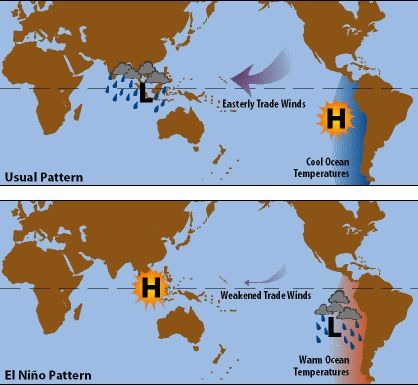Fueled by the Sun, the Earth's oceans and atmosphere follow a cyclical
pattern of change. Sunshine warms the ocean waters each day, and the waters
cool at night. Sometimes the waters gain more heat during the day than
they lose overnight, and they then grow warmer and warmer. The warming
ocean waters warm the air, causing it to rise. As the warm air rises and
spreads, it changes global atmospheric circulation patterns (see figure).
The warm air over the ocean increases evaporation, causing clouds and rain
that block the Sun and eventually lead to cooling of the waters. After
ocean temperatures cool to normal levels, the atmosphere also returns to
previous circulation patterns, completing the Weather patterns in many parts of the world appear to be related to different phases of the ENSO cycle. One of the stronger relationships is between the warm-ocean El Niño phase of the cycle and drought in southern Africa. When the Pacific Ocean waters are cool, called "La Niņa", this area tends to be rainy. Relationships to patterns in other parts of Africa are less clear, although the weather tends to be wetter in eastern Africa during El Niņo and drier during La Niņa. Scientists are developing several long-range weather forecasting tools. Many of these tools are based on ENSO. If such forecasts prove reliable, they would be quite valuable in providing early warning of drought. How Did El Niño and La Niņa Get Their Names? "La Corriente del Niño" (Spanish for "the Current of the [Christ] child") was the name that fishermen gave to warm ocean temperatures that tended to appear around Christmas off the Pacific coast of South America. We now recognize this to be part of a global cycle of weather and the oceans. Since "El Niņo", meaning "the little boy" is used to refer to the warm part of the cycle, the opposite part of the cycle, when waters in the Pacific are cool, is now called "La Niņa" meaning "the little girl".
Back to youth page | Back to vf-tropi.com main page
|

